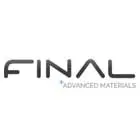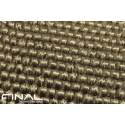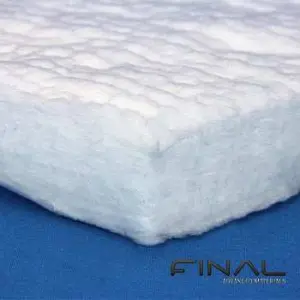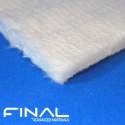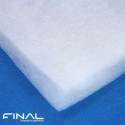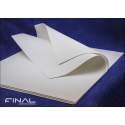High Temperature Felts
Overview: High Temperature Felts
Final Advanced Materials offers felts and blankets resistant to high temperatures up to 2,500 °C. These products are mainly used for thermal and sound insulation for the manufacture of industrial furnaces, or as a component of thermal protection. Many industries use felts for their manufacturing processes. With varying densities and thicknesses, some references can be aluminized to improve their thermal properties.
Applications of Felts
- High temperature protection
- Electrical, thermal, acoustic insulation
- Alternative to asbestos and ceramic fibres
- Catalytic heaters
- Industrial furnace insulation
Comparative Table
|
Property |
Unit |
Basalt |
E-Glass | Silicate | Pure Silica | Biosoluble | Ceramic | Graphite | Zirconia |
|
Density |
kg/m3 |
120 to 137.5 |
100 to 160 |
120 to 170 |
20 |
64 to 128 |
288 |
80 |
0.24 to 0.64 |
|
Max. Operating Temperature |
°C |
600 |
550 |
1,000 |
1,000 |
1,000 |
1,260 |
500 |
2,000 |
|
Peak Temperature |
°C |
700 |
840 |
1,200 |
1,200 |
1,200 |
1,760 |
2,000 |
2,500 |
Our range of Felts
Basalt Fibre Felts, up to 800 °C
Basalt fibre felts are made from basalt fibres of 8 to 16 μm. They can withstand peak temperatures up to 800 °C and operating temperatures up to 700 °C. They do not burn, do not melt and produce neither smoke nor toxic gases. These products are also ecological and recyclable. They are mainly used as electrical, thermal, and acoustic insulators. In addition, basalt fibre is the most environmentally friendly high temperature resistant material when it comes to both manufacturing and recycling it. These felts are used in the industry for electrical and thermal insulation.
Applications
- Electrical insulation
- Thermal insulation
E-Glass Fibre Felts, up to 700 °C
E-glass fibre needle felts offer excellent mechanical, chemical and dielectric properties. Moreover, E-glass fibre is valued for its excellent electrical insulation properties and its resistance to high temperatures. They can indeed withstand operating temperatures up to 550 °C and peak temperatures up to 700 °C. Different treatments can improve the felts' properties, such as their resistance to cutting, wear, radiant heat or to splashes of molten metal. They are mainly used in the naval and automotive industries for thermal and acoustic insulation.
The E-glass fibre needle felts provided by Final Advanced Materials are untreated or available with an adhesive, steel or an aluminium finish.
Applications
- Acoustic insulation
- Thermal insulation
Ceramic Fibre Felts, up to 1,650 °C
Final Advanced Materials offers an innovative continuous polycrystalline ceramic fibre. The metallic oxides in its composition make its transformation into ceramic textile particularly easy. Its mechanical and thermal performance outperform that of other fibrous materials such as aramid, silica, quartz, or glass. Our ceramic fibre felts are mainly made of alumina (Al2O3) at different proportions. Depending on their composition, they can withstand classification temperatures up to 1,650 °C. Thanks to their excellent thermal resistivity, these felts are used in the industry for high-temperature applications, such as thermal shield or calcining kilns for porcelain.
Final Advanced Materials provides ceramic fibre felts with a thickness of 13 or 25 mm.
Applications
- Thermal shield
- Calcining kilns for porcelain
Silicate Fibre Felts, up to 1,200 °C
Silicate fibre felts can withstand operating temperatures up to 1,100 °C and peak temperatures up to 1,200 °C. Asbestos-free and inorganic, these products do not contain toxic substances and pose no health risk during handling. Thanks to their good thermal and mechanical properties, they are reliable alternatives to asbestos based products. These felts are mainly used in the industry for thermal and electrical insulation, soundproofing as well as the assembly of heat protections.
The felts provided by Final Advanced Materials do not contain any organic binders. The fibres are mechanically bonded, which makes the felt compact, flexible and stable during their processing.
Applications
- Thermal insulation
- Electrical insulation
- Soundproofing
- Component for heat protection's assembly
Pure Silica Felts, up to 1,200 °C
Pure silica fibre felts have a proportion of silica greater than 99.95 %. They are composed of silica fibre combined with polyvinyl alcohol. The silica fibre of their composition is not only one of the most effective high-temperature materials but is also among the most reliable and ecological on the market. They can also withstand peak temperatures up to 1,200 °C. There is no shrinkage even with operating temperatures up to 1,000 °C and they maintain very low thermal conductivity as well as excellent mechanical properties. These felts are particularly appreciated in the aerospace industry for the insulation of engines thanks to their outstanding insulating and fireproof properties as well as their resistance to vibrations and their very long life.
Final Advanced Materials provides pure silica fibre felts untreated, calcined or with a polyvinyl acetate (PVA) as binder. These treatments removes the fibres on the surface, thus improving their performance and their resistance to heat and alkaline medium.
Applications
- Insulation of industrial furnaces
- Catalytic supports for heating systems
- Replacement of asbestos and ceramic fibre
- Thermal insulation in the manufacture of optical fibre
- Insulation of engine in aeronautics
Biosoluble Fibre Felts, up to 1,200 °C
Biosoluble fibre felts are obtained from long fibres of alkaline earth silicate. With high thermal stability, they retain a flexible fibrous structure up to a temperature of 1,200 °C. Their high-temperature insulation performance is remarkable. This range of product contains no binders or lubricants and emits no smoke or odour when heated. Biosoluble fibre felts are flexible and easy to cut or install. Biosoluble fibre blankets are available laminated with an aluminium film to improve the thermal properties of the sheets. Biosoluble fibres felts’ composition excludes all carcinogenic classification as per Q in directive 97/69 EC, unlike pure silica and silicate fibres. Biosoluble fibres felts are an ideal solution to replace ceramic fibres.
Applications
- Chimney, furnace and pipe insulation
- Heating and furnace lining
- Heat shield
- Component in the manufacture of thermal protection
Soft Carbon & Graphite Felts, up to 2,000 °C
Carbon and graphite felts with thicknesses of 6 and 12 mm with a width of 1,200 and 1,270 mm are available. Specific widths can be provided and special shapes can be cut to your specifications. Soft carbon and graphite felts offer many advantages. They have low thermal conductivity which leads to energy savings of up to 75 %, high resistivity (coupling in an inductive field only occurs above 12 kHz) and do not charge with electrostatic energy. They are thermically stable in oxidizing atmospheres up to 350 °C, in protective or vacuum atmospheres up to approximately 2,000 °C for graphite and 1,000 °C for carbon. Their composition is very pure with very little sulphur and ash content.
Applications
- Thermal insulation for vacuum furnaces and inert gas furnaces
- Heated smelting and holding furnaces
- Inductively heated furnaces
- Filters for hot and/or corrosive gases and liquids, for molten metals
- Backing strips for soldering and welding
Rigid Graphite Felt, up to 2,000 °C
Rigid graphite felt is available with a thickness of 40 mm (max. size 1,524 x 1,219 mm). This product is made of graphite fibres and a carbon binder. It is suitable for temperatures up to 2,200 °C. Specific widths and shapes can be cut.
Applications
- Thermal insulation
- Support element
- Component of high-temperature furnaces
Zirconium Oxide Fibre Felts, up to 2,100 °C
Zirconia fibre felts are technical textiles produced using a manufacturing process developped by Zircar Zirconia Inc. These needled felts are made of 100 % zirconia fibre with a diameter ranging from 4 to 6 µm, stabilised with 10 % yttrium oxide. They offer high resistance to extreme temperatures. Depending on their composition, these products can withstand operating temperatures up to 2,000 °C and peak temperatures up to 2,100 °C. Moreover, they were designed for highly corrosive environements and therefore don't react to alkaline vapour, salts or hot and concentrated solutions.
Other versions have been treated to enhance their properties and are also available:
|
Advantages |
|
|
ZYF-50 ZYF-100 ZYF-150 |
Exceptional thermal insulation even beyond 1,930 °C Flexible up to 1,350 °C Low outgassing and odor even at high temperature Light and porous structure Low thermal conductivity High thermal stability High resistance to corrosive, oxidizing and reducing atmospheres |
|
ZYF-100A |
Similar to the ZYF-100 version but with a lower level of sodium |
|
ZYF-A2.13 |
Similar to the ZYF-150 version but harder Filled with alumina powder and high fired to a rigid board |
|
ZYF-S.75G |
Similar to the ZYF-100 version but more flexible Filled with 0.75 g of silica powder per 1 g of ZYF, remaining pliable |
|
ZYF-Z1.5G |
Similar to the ZYF-100 version Filleded with 1.5 g of zirconia powder per 1 g of ZYF and dyed green for identification |
|
Applications |
|
|
ZYF-50 ZYF-100 ZYF-150 |
All-purpose High temperature setter High temperature shield and cover High temperature insulation Crystal growth |
|
ZYF-100A |
All-purpose Glass melting High temperature setter High temperature shield and cover High temperature insulation Crystal growth Electrolytic cell gasket |
|
ZYF-A2.13 |
Diffusion burner membrane for fuel fired heaters installed in long-haul trucks and high end passenger cars Setter plate for vacuum sintering flat sheets of powdered metal materials |
|
ZYF-S.75G |
Gasket material in fuel cells |
|
ZYF-Z1.5G |
|
Felt type ZYF can be reinforced with Zircar Zirconia cement type ZR-CEM or with Zircar Zirconia hardener type ZR-RIG.
Other coatings or coatings are possible according to your needs.
Physical variables included in this documentation are provided by way of indication only and do not, under any circumstances, constitute a contractual undertaking. Please contact our technical service if you require any additional information.
High Temperature Basalt Fibre Felts 800 °C
High Temperature Biosoluble Felts 1200°C
High Temperature E-Glass Fibre Felts 700 °C
High Temperature Graphite Felts 2,000 °C
High Temperature Pure Silica Fibre Felts 1,200 °C
